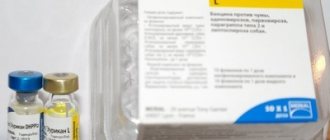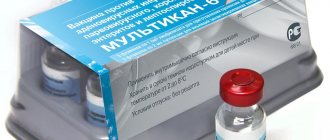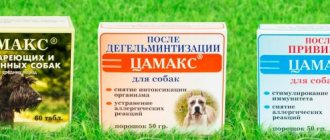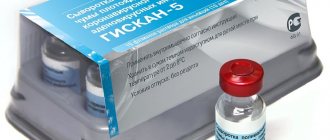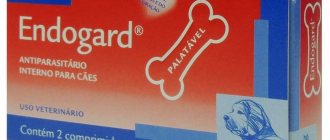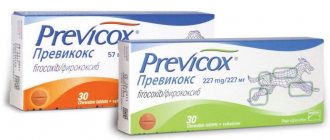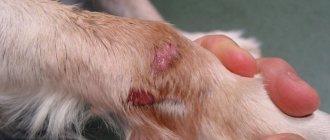Today, every caring pet owner knows how important it is to vaccinate their pet on time against diseases dangerous to its body. Ignoring the benefits of vaccination for dogs can cost your pet not only health, but also life. Therefore, the question of the feasibility of vaccinations, their quality and safety is currently very relevant. Veterinarians around the world actively recommend vaccinating pets, and at the same time advise using Eurican as one of the best on the world market.
Eurikan is a complex drug of French origin for the prevention of many canine infectious diseases, which allows the animal to develop stable antibodies that protect it from damage by pathogens of deadly diseases. Provided that the vaccinated animal does get sick, you can be sure that it will survive the disease in a mild form and without any complications. There are two modifications of the vaccine: version L and LR. Among the indications for the use of the prophylactic drug Eurikan DHPPI2-L, canine infections such as canine distemper, parvovirus, adenovirus, and parainfluenza should be highlighted. It also allows you to develop immunity against leptospirosis, and its extended version Eurican DHPPI2 (LR version) provides, among other things, protection against rabies. Eurican for dogs is a clear liquid in appearance, packaged in glass bottles of 1 ml of active ingredient. One of them contains a dry, lyophilized component, and the other contains a suspension. Each such bottle must be provided with a label indicating the manufacturer, its trademark, name of the product, its quantity, as well as recommendations regarding the method of administration, expiration date of the product and serial number. This prophylactic product should be stored in a dark, dry place at an air temperature of 2 to 80 C.
Operating principle
The principle of action of the drug is based on the ability of its constituent components to stimulate the development of stable immunity against a number of infectious diseases in pets. Eurikan contains the following strains of pathogens of dangerous diseases:
- plague;
- adenovirus type 2;
- parainfluenza virus type 2;
- leptospirosis;
- parvovirus;
- rabies (version of the Eurikan vaccine for dogs DHPPI2-LR).
Read. Anthelmintic for dogs before vaccination: rules and recommendations
This remedy promotes the development of stable immunity against the listed pathogens within two weeks. This immune protection lasts for a year. Therefore, after 12 months, revaccination is mandatory.
Description and composition of the vaccine Eurikan
The French vaccine “Eurucan DHPPI2” is available in 2 variations, differing in the number of strains contained. The “LR” label indicates the presence of the “rabies” strain (canine rabies) and is used to designate a combination vaccine used for a larger number of pathogens.
Regardless of the labeling (“L” or “LR”), vaccines have a similar composition of incoming components:
- Liquid . It is represented by a cloudy liquid that forms a sediment during long-term storage. Temporary clarity obtained after the formation of sediment is eliminated by thorough shaking. The suspension includes weakened strains of pathogens: leptospirosis;
- rabies (only when labeled “LR”).
- strains of adenovirus and parainfluenza type 2, parvovirus, plague virus;
When packaging, 2 types of glass bottles are used to separate dry ingredients from liquid ones. The volume of each bottle is 1 ml, and the injection dose is obtained by mixing the contents of 2 bottles: dry and liquid.
The drug is packaged in plastic boxes containing 10 or 50 injection doses. For tightness, each bottle is closed with a rubber stopper and an aluminum cap.
The volume of each bottle is 1 ml
How to use correctly
The use of the vaccine should occur under the supervision of an experienced veterinarian and preferably in a specialized clinic. Before injection, deworming must be carried out, even if the animal does not have symptoms of helminthic infestation.
The Eurikan vaccine is administered to a puppy in an amount of 1 ml, regardless of size and age. Primary vaccination always requires repeated administration of the prophylactic agent after 3-5 weeks. All subsequent Eurican vaccinations are carried out within a year (once every 12 months). At 7 weeks, it is advisable to administer Eurican DHPPI2 version L to puppies. If an epidemic of leptospirosis is declared in the region where an animal lives, it should be revaccinated 6 months after the scheduled dose of Eurican is administered. Immediately before administration, it is necessary to combine the contents of two bottles. To do this, you need to follow the following algorithm of actions:
- draw the suspension into a sterile syringe;
- introduce a clear liquid into a bottle of dry vaccine by piercing the rubber cap;
- turning the bottle in different directions, bring the resulting composition to a state of homogeneity;
- treat the injection site (scapula area, thigh) with alcohol applied to a swab;
- perform a subcutaneous injection with the introduction of the entire contents of the second bottle.
Read. Vanguard 5: vaccine for dogs with coronavirus
It is important to remember that a hard lump may appear at the injection site, which will resolve on its own after 3-4 days (maximum after a week). This formation does not require additional treatment, as it does not pose a threat to your pet’s health. The same cannot be said about an anaphylactic reaction after vaccination. Cases of such a complication are extremely rare, but if they develop without the administration of hormonal drugs, the pet may die.
Storage conditions and shelf life
Eurican should be stored at a temperature of 2 to 8 degrees.
Eurican is stored away from moisture and sunlight.
Storage at temperatures below 2 degrees, above 8 degrees and near food products is not allowed. There is a separate shelf in the refrigerator for the drug.
If the opened bottle is not used within half an hour, or contains mold or impurities, then it is disinfected by boiling for 10 minutes and disposed of. The rule also applies if the expiration date has expired.
Eurican should not be frozen. Otherwise, it must be disposed of.
If the storage rules are followed, eurican is good for 2 years from the date of its production.
When is it better to refuse vaccination?
Despite the fact that the Eurican vaccine is harmless, it has a number of contraindications for use. This prophylactic agent is strictly prohibited from being administered in the following cases:
- the presence of individual intolerance;
- condition after planned or extraordinary deworming, when 10 days have not passed;
- pregnancy period at any stage;
- exhaustion of the body by a chronic illness or acute forms of diseases, regardless of origin, in which the body is in a weakened state;
- immediately after suffering viral infections, even if the pet has no manifestations of the disease;
- the L version is not administered to puppies under 7 weeks of age, and the LR version is prohibited before 3 months of age.
Vaccination should be abandoned if the product is expired or the integrity of its bottles is compromised. You should also pay attention to the solution itself. The presence of impurities or sediment in the liquid part of the drug indicates a low-quality product, which is prohibited from injecting according to the instructions.
Read. Vaccinations and vaccination of cats against lichen
Side effects of the rabies vaccine
Side effects of the drug may include:
- the formation of a small compaction in the injection area , which does not require special intervention and disappears after 2-3 days on its own;
- the occurrence of an anaphylactic reaction in conditions of individual intolerance to the components, requiring symptomatic treatment.
Side effects include the possibility of anaphylactic shock.
In rare cases, a vaccinated dog experiences complex problems with the gastrointestinal tract (diarrhea, nausea), loses appetite and is in a lethargic state. Such symptoms are observed in the early stages of infection.
If your pet's condition does not change or worsens within 24 hours, consult your veterinarian.
Reviews of Eurikan
Julia: “Our Max is already five years old, and all this time we have been vaccinating him with Eurican every year. In defense, I would like to say that it never caused Max side effects, and was always well tolerated, providing reliable immunity. Igor: “We have four German Shepherd dogs living in our country house. From an early age, the veterinarian administers the Eurican vaccine to them. During this time, they never got sick, felt quite well, and I didn’t notice any changes in their behavior. Therefore, now I can confidently recommend Eurican to everyone who wants to protect their pet from disease. On top of that, the product is quite inexpensive, especially considering that treating a pet is much more expensive (and it’s not always possible).
What is dog vaccination
Vaccination is a preventive procedure aimed at reducing the risk of contracting infectious diseases. The vaccine itself is the causative agent of the disease in a weakened form. The dog's body is forcibly infected with a small amount of infection, thanks to which it begins to fight it. And, in the end, immunity is developed.
As a rule, dogs are vaccinated against infections such as canine distemper, hepatitis, adenovirus, parvovirus and coronavirus infections, leptospirosis, rabies. All these diseases are very difficult for animals to tolerate, so it is easier to prevent them than to treat them.
Carrying out this procedure does not exclude the possibility of contracting any of the above infections, but it guarantees that the disease will be mild and without complications.
Additional vaccinations (as needed):
against dermatomycosis (microsporia and trichophytosis) with the Polivak-TM vaccine (Russia), carried out 2 times with an interval of 10 - 14 days, annually,
or the Vakderm vaccine (manufacturer Vetzverotsentr, Russia), done 2 times with an interval of 10 - 14 days, annually.
Regimen for the Nobivac vaccine (Intervet, Netherlands): Nobivac Tricat: against viral rhinotracheitis, calicivirus infection and feline panleukopenia.
Done at the age of 8-12 weeks - the first vaccination. After 3-4 weeks - re-vaccination. It is given together with the Nobivac Rabies rabies vaccine.
Scheme for Leucorifelin (Merial, France):
The first vaccination with Leucorifelin (against panleukopenia, herpesvirus and calicivirus) is at 7-8 weeks.
Revaccination - after 3-4 weeks with the Leucorifelin Quadricat vaccine (against panleukopenia, herpesvirus and calicivirus plus rabies).
Revaccination must be repeated every year.
Scheme for Multifel-4 (Narvak, Russia):
- Multifel-4 is used against panleukopenia, rhinotracheitis, calicivirus and feline chlamydia viruses.
- The first vaccination for a kitten is at 8-12 weeks.
- Repeated after 21-28 days.
- Revaccination - annually
Additional vaccination (if necessary) - in addition to the schemes above.
Polivak-TM (Russia) - vaccine against ringworm.
It is done annually, twice with an interval of two weeks.
Why get vaccinated and is it necessary?
For many dog breeders, the question of the need for vaccinations remains a mystery. After all, animals in the wild can do without them and survive just fine.
And this is a big misconception:
- Firstly, dogs are already domesticated animals and their immunity is weaker than that of wild animals.
- Secondly, in the wild, the life expectancy of animals is much lower and they often die from infectious diseases.
- Well, thirdly, our favorite little animals do not live in the forest, where the danger of infection is much lower, but in a city where there is a lot of all kinds of chemical and natural waste, harmful emissions and other stuff. This means that the risk of getting infected in the city is much higher.
This is why the need for vaccination, in my opinion, is beyond any doubt. If the animal gets sick, the treatment will be very difficult and may even lead to the death of the dog. Therefore, it is better to vaccinate and prevent infection than to fight it.
Moreover, it is also necessary to vaccinate those animals that do not leave the apartment, since they can become infected even from their owner’s outdoor shoes or clothes.
Well, if you are going to take your animal with you when traveling by train or plane, then this question disappears altogether. Moreover, in the latter case, all vaccinations must be reflected in the veterinary passport and certified with the stamp of the state veterinary clinic.
General rules for vaccinating pets
The vaccination rules for both dogs and cats are the same:
- The animal must be healthy at the time of vaccination.
- 10 days before vaccination, it is necessary to carry out treatment against skin parasites - ticks, fleas, lice, as well as deworming.
- Although your pet will be examined by a veterinarian before vaccination and will make sure he is in excellent health, it is advisable to monitor the animal, its appetite, general condition for 3 days before vaccination, and also measure its temperature at the same time.
Normally, in healthy dogs it is 37-39C, in puppies – no higher than 39.5C, in kittens – from 38.5 to 39.5C, and in adult cats and cats – 38-39.5C.
Remember! If your pet is allergic, notify your veterinarian. It is possible that the animal will be given diphenhydramine before vaccination.
Vaccination schedule from birth
Your dog should be vaccinated according to schedule. To do this, you need to know the order and timing that must be maintained between vaccinations.
The first vaccination is done 1.5-2 months after the puppy is born. You may ask why not right away? But because from birth the baby receives immunity from the mother. After a month and a half, the immunity weakens and the puppies begin to get sick. This is where you need to start getting vaccinations to avoid infecting your pet with various infections.
I'll repeat it again. If you want to take your pet abroad, then you need to administer only imported vaccines, for example, Nobivak, Hexadog, Eurikan, etc.
Let's look at vaccination schemes with these drugs. My Jackusik and I have traveled abroad several times, so we vaccinate him with Nobivak. Let's start with him.
Nobivak
The first vaccination can be carried out with the Nobivak Puppy DP vaccine at the age of 4 weeks, followed by the use of the Nobivak DHPPi vaccine according to the following scheme:
- 2 months (8 weeks) – second vaccination – Nobivak DHP + Nobivak L.
- 3 months (12 weeks) – third vaccination – Nobivak DHPPi + Nobivak LR.
After the third vaccination, there is a 14-day quarantine, and then you can go outside for a walk!
Further like this:
- After 1 year - the fourth vaccination - Nobivak DHPPi + Nobivak LR.
- Next: 1 time annually and for life – Nobivak DHPPi + Nobivak LR.
Here is our Dzhekushka's passport. These are necessary vaccinations that are given once a year.
Nobivac Rabies with a mark in the veterinary passport.
Nobivak DHPPi + Nobivak Lepto with a mark in the veterinary passport.
Eurikan
We go according to this scheme:
- 2 months (8 weeks) – first vaccination – Eurican DHPPI2 + Eurican L.
- 3 months (12 weeks) – second vaccination – Eurican DHPPI2 + Eurican LR.
- After 1 year - the third vaccination - Eurican DHPPI2 + Eurican L.
- Next: 1 time annually and for life – Eurican DHPPI2 + Eurican L.
Hexadog
In the following way:
- 2 months (8 weeks) – first vaccination – Eurican DHPPI2 + Eurican L.
- 3 months (12 weeks) – second vaccination – Hexadog.
- After 1 year - the third vaccination - Hexadog.
- Next: 1 time annually and throughout your life - Hexadog.
Immunity after vaccination develops no earlier than 10 days later. Therefore, after each vaccination, it is imperative to quarantine for 14 days.
And do not forget that the veterinarian must mark any vaccination in the veterinary passport. If he didn't do this, then be sure to tell him about it.

